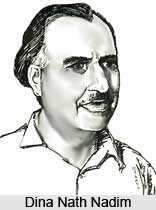 Dina Nath Nadim was a famous name in the Progressive movement in Kashmiri literature. Born in 1916, Srinagar he was an outstanding poet of original thought and diction. He was born in very poor parents. He taught at the Hindu High School, where he eventually became the head. His contribution to the development of Kashmiri theatre is quite significant as he introduced the opera into Kashmiri as a viable literary form. His first opera, Bombur ti Yimbirzal or `Bombur and Yimbirzal staged successfully, allegorically represented the political upheaval of 1953 in Kashmir. Welcoming the change, autumn and Storm are denounced for intriguing against the `innocent` love of Bombur and Yimbirzal.
Dina Nath Nadim was a famous name in the Progressive movement in Kashmiri literature. Born in 1916, Srinagar he was an outstanding poet of original thought and diction. He was born in very poor parents. He taught at the Hindu High School, where he eventually became the head. His contribution to the development of Kashmiri theatre is quite significant as he introduced the opera into Kashmiri as a viable literary form. His first opera, Bombur ti Yimbirzal or `Bombur and Yimbirzal staged successfully, allegorically represented the political upheaval of 1953 in Kashmir. Welcoming the change, autumn and Storm are denounced for intriguing against the `innocent` love of Bombur and Yimbirzal.
The powerful songs are still popular as folksongs. Another opera, Nyikyi ti bedyi or `Good and Evil` was meant for children and first performed at the Hindu High School in 1956. Based on painstakingly composed songs, Nadim`s most important opera, Vitasta, was universally admired for its melopoetic treatment of the flow of the river Vitasta or Vyath through the Valley. The metaphoric imagery and musical contrivances make it a sublime artwork. In collaboration with Noor Mohammad Roshan, Nadim wrote Hyimal ti Negymy i.e. `Hyimal and Negyray`. This was a modern version of the immortal Kashmiri love story of a Brahman girl and the Serpent Prince of the netherworld. Some other operas written by him in the 1950s and 1960s were Safar ti shahjar or `Journey and Shades`, Madanvar ti Zuval Mai or `Madanvar and Zuval Mai`, and Shihily kul or `Shady Tree`. Dina Nath Nadim died in 1988.




















